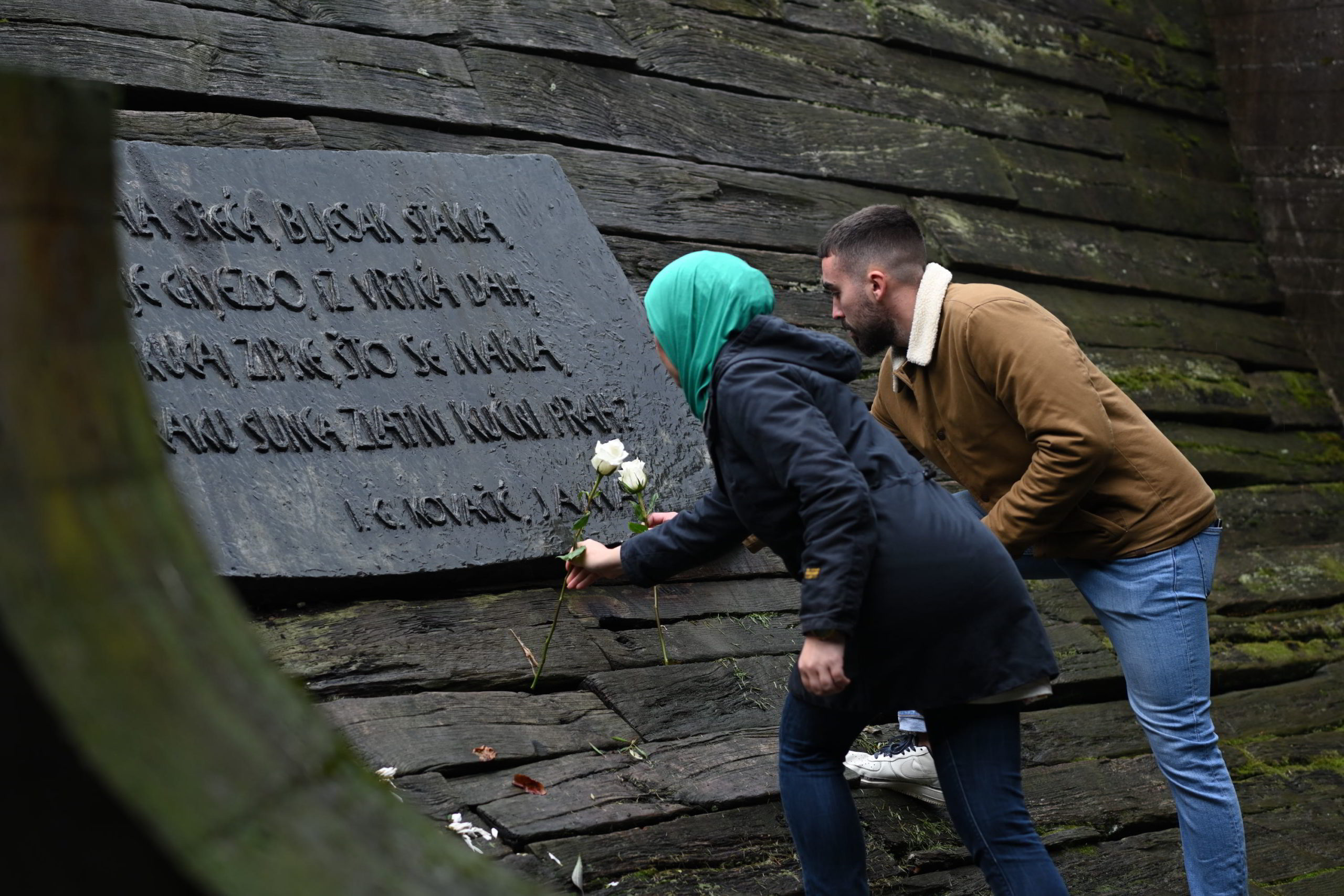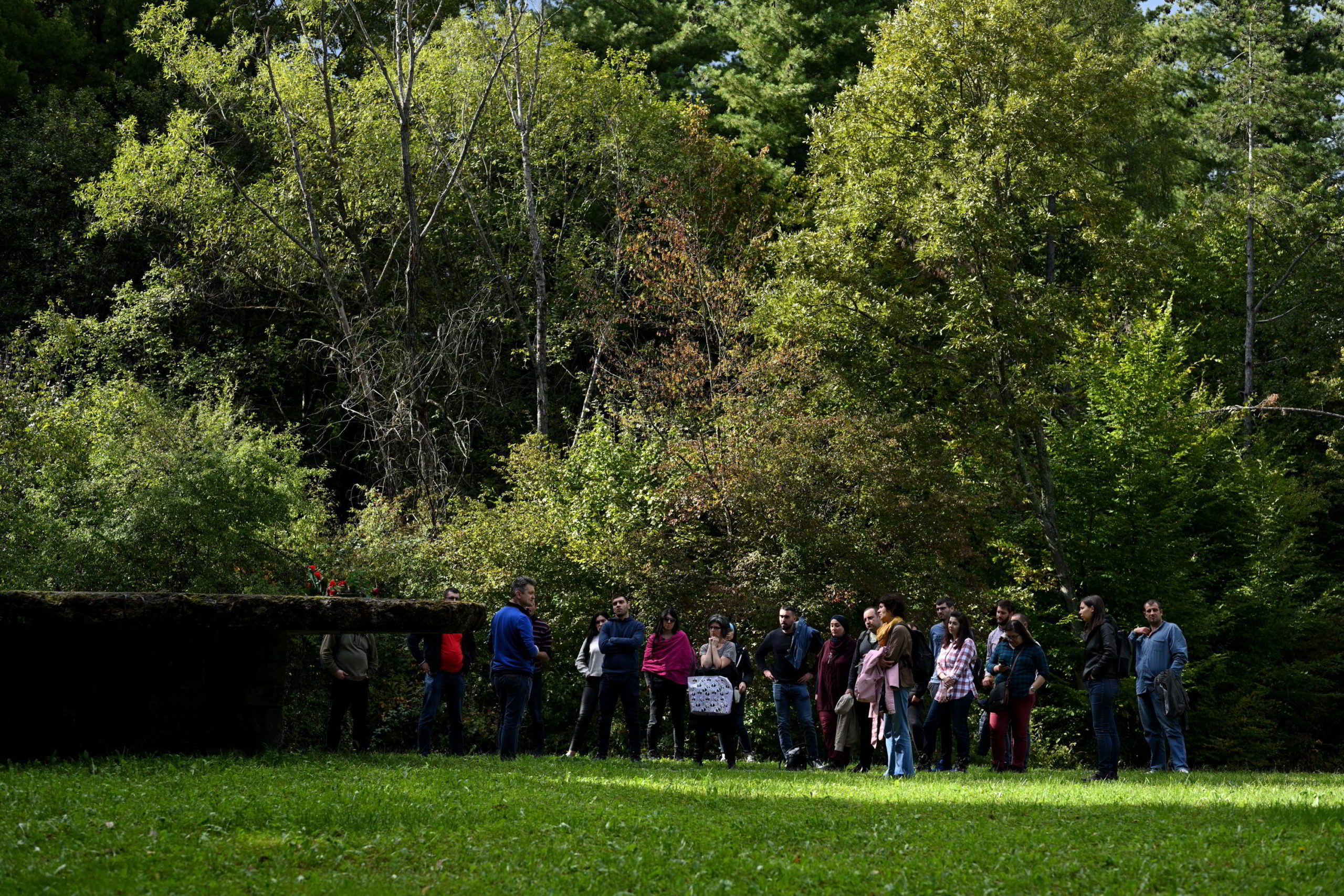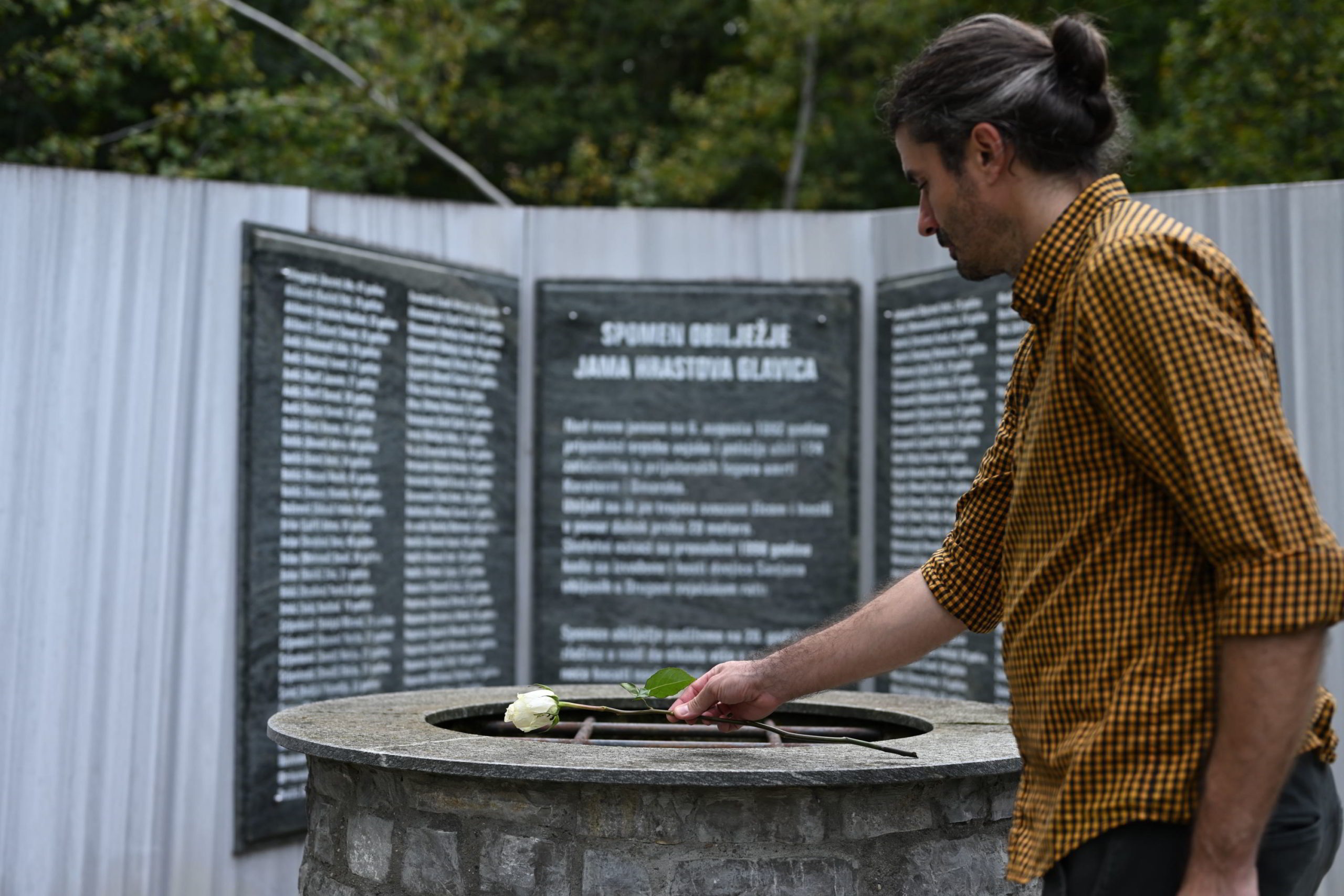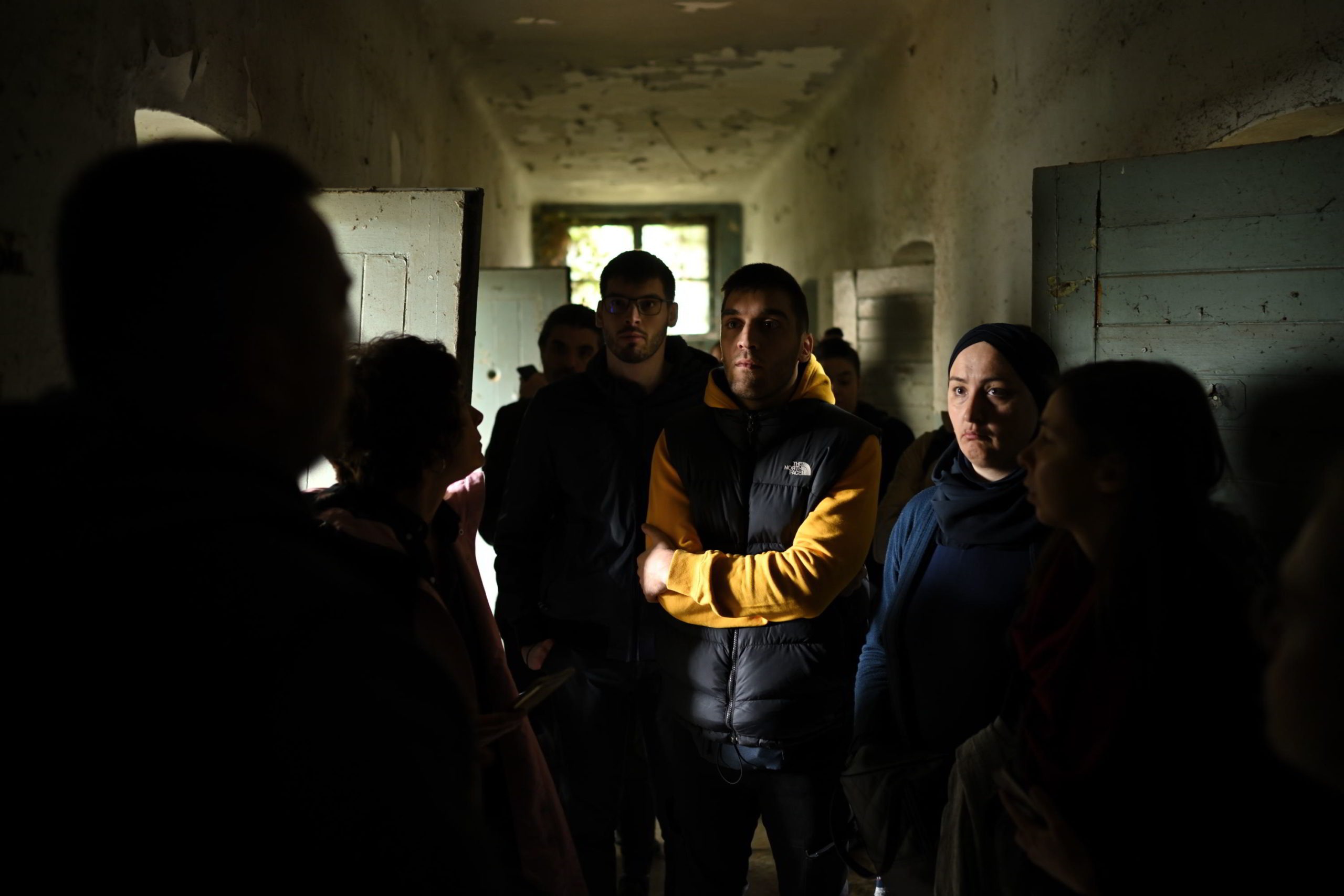The past differs from the present
in one significant way
– it never flows in just one direction
Georgi Gospodinov
What do we remember from our history today and how, and what did we used to remember yesterday and how? Will we have anything to remember tomorrow? What must we (not) forget? Are we as societies condemned to being enemies forever, trapped in our national narratives? Are we forever condemned and tied down by our wartime past that threatens to repeat itself? These are just some of the questions I heard and/or asked, discussed and/or re-examined, brought to and/or took away from the study trip “The Present of our Past” organised from 25 September to 1 October 2022. The study trip organised by the Centre for Nonviolent Action (CNA) included visits to marked and unmarked sites of suffering related to the Second World War and the wars of the 1990s in the wider Jasenovac and Novska area in Croatia, and that of Donja Gradina, Kozara, Prijedor and Sanski Most in Bosnia and Herzegovina. This wider area at the foot of Mount Kozara was marked by mass suffering of the population, not just in the Second World War, but also in the 1991-1995 war. The study visit brought together participants from Serbia, Croatia, Bosnia and Herzegovina, Macedonia and Montenegro, making up a total of twenty-two with the CNA team, and the participants were mostly historians, but there were also peace activists, reporters, psychologists and students.
The trip was envisaged from the start as giving space and opportunity to gain direct insight into memory practices and policies in this region, to help us learn how they are formed and reformed, the reasons why they last so long or only briefly, whether they interact with and influence each other over time and distances and how, and who they (do not) suit and why. And all this through visits to memorials and museums, marked and unmarked sites of suffering; through history lessons and guided tours, and in conversation with historians, witnesses, victims and war veterans turned peace activists. In addition, opportunities for deeper self-reflection as well as exchange with others were provided through reflection sessions organised with people we met and among the group of participants.
Individuals as a Dam against Revisionism
Once a single memorial complex, with the dissolution of SFRY, the Jasenovac Memorial was divided both geographically and administratively into two independent institutions: The Jasenovac Memorial Site in the Republic of Croatia and the Donja Gradina Memorial Site in Bosnia and Herzegovina, i.e. it is now located in two countries, on either side of the Sava River which is today a hard and dreary border. The border crossings, which took longer than anticipated, in the first two days of the study trip seemed to signal that we were not just crossing a rather small area, but that we were also travelling through time. From one dimension of time into another, from one parallel reality into another as they compete for primacy, for the exclusive right to be the one and only owner of the true image of the past, where truth is less important than having possession of it. This is a feeling that persisted for me throughout the trip.
The former Stara Gradiška Camp, that almost two-centuries long continuity of evil (it had been established as a prison in 1799 for French prisoners of war) and human suffering, can be accessed only at one’s own risk, with the utmost caution, because the buildings, including the memorial to the victims, are in a catastrophic state. The situation is not much better in Donja Gradina, though there is no risk of buildings collapsing in on themselves, but the level of investment in maintaining the memorial complex is the same.
Our partial disappointment with what we saw in the permanent museum exhibition of the Jasenovac Memorial Site (the exhibition dates from 2006) was shared by our guide Đorđe, a historian and curator, and his colleagues. Visitors without prior knowledge about the camp cannot learn almost anything about the atrocities and horrors suffered by people in Jasenovac from the exhibition. We found out that the exhibition authors did this deliberately in order to avoid traumatising visitors and because they did not want to make a museum dedicated to crime and criminals, but a museum dedicated to victims. They decided to present the victims as individuals. According to our guide and host, this may have been justified in 2005/2006, but after the deluge of revisionism started in 2014, it became important and still is important to show everything, while leaving people the choice of whether to go look at explicit images of the crimes or not. Problems with the exhibition do not end there. As opposed to the previous exhibition, this one is neither chronological nor thematic, and what is particularly problematic is that it seems to “parachute you down into 1941, into Jasenovac, with no context about how it all came about… the key question for this exhibition, if you put yourself in the shoes of an average visitor who does not know much about Jasenovac, is whether you can learn from the exhibition about what happened here?” Đorđe continued with unconcealed resignation.
Neglect, lack of funding or political will, an inexplicable culture of forgetting, the lack of a clear vision or goal, these are just some of the reasons for things being as they are. The number of victims being minimised on one side of the river (excluding, of course, the work of people at the Jasenovac Memorial Site) and maximised on the other seem to only reinforce the material consequences of all these reasons for both memorial complexes – neglect and disrepair. The other, much more profound and damaging consequence is the absence of institutional cooperation that makes any future serious research or action related to this space impossible to implement. Our guides, historians and curators of the Donja Gradina and Jasenovac memorial complexes, Dejan Motl and Đorđe Mihovilović, respectively, are proof that there is cooperation, but only at the individual level. They are authors of Zaboravljeni – Knjiga o posljednjim jasnovačkim logorašima [The Forgotten: A Book about the Last Prisoners of Jasenovac], published in 2015, which has the most extensive and precise analysis of the last days of the Jasenovac concentration camp and the break-out of its prisoners, as well as biographies and photographs of the 169 survivors. The book could only have been written in cooperation, because the survivors were from BiH, Serbia and Croatia, and accordingly, it was very significant who came to them looking for information and from where. The authors volunteered their time and worked with enthusiasm, receiving no institutional support, or the recognition their book deserves.
Under attack from multiple sides, both from the Croatian and the Serbian side, Đorđe and Dejan struck us as uncommonly brave and highly professional individuals, and as one of the participants put it, a real “dam against revisionism”. There is still reason to fear that these individual efforts will not be recognised and properly institutionalised, because that is the only way to ensure that no one who comes after them can reverse the benefits and values their work has contributed to the culture of memory and its preservation. A dam against revisionism built exclusively of individuals, who knows how long it can last.
Thank you, Đorđe. Thank you, Dejan.

Revisionism at Work
The Trokut Memorial Site in Novska Municipality contains the remains of the monument to fallen fighters and victims of fascist terror from the Second World War. Specifically, fighters of the 21st Serb Division that in April 1945 liberated Nova Gradiška, Okučani, Novska and Jasenovac from Ustasha and Nazi forces. The monument was dynamited late in 1991 or early in 1992 and left in ruins for 25 years. The remains of the monument were neglected and overgrown with vegetation, while the only remaining part of the monument, a pedestal with a flat concrete plate, was invisible. Thanks to an initiative by the Serbian National Minority Council in 2017, the area around the monument was cleared and it can now be accessed. Right next to this monument to the Partisans, in 2009 another monument was officially inaugurated in honour of 314 Croatian defenders who were killed on this part of the Slavonian battleground in 1991 and 1992. Just twenty meters or so from the destroyed Partisan monument stands this new monument, “its back turned”, and dominates the view, practically blocking out the old monument. At the entrance to the memorial site, which is covered by video surveillance, there is a controversial plaque known as the HOS (Croatian Defence Forces) plaque. It is very controversial because of the HOS emblem that contains the Ustasha salute – “za dom spremni”.
The plaque was initially installed in Jasenovac, in the centre of town, on the building of the local kindergarten. Installing a plaque saying “za dom spremni” in Jasenovac is a shameful act of open political provocation. Due to, primarily, strong reactions from both the public and the media, and on account of great pressure, the Croatian government was forced to remove the plaque, which to a portion of the Croatian public and media was commendable. However, “a rotten compromise was struck. The plaque was allowed to be installed in a different location, which gives the whole story an added level of bizarreness,” we are told by Milan Radanović, historian, researcher and activists, a native of Nova Gradiška, who was our guide at this location.
From the destruction and neglect of a monument honouring those who fought against the Ustasha creed to a plaque with the Ustasha salute. Devastating. A bit of neglect, a bit of destruction, a bit of new construction, what else is historical revisionism if not that, the Trokut in Novska is a prime example of how a counter-narrative is put into practice.

The situation is similar at Mount Kozara. Approaching the Mrakovica Memorial Area, you are greeted by a giant cross, erected in 1993. Plaques bearing the names of fallen Partisans surround the space where historian and curator Boris Radaković “holds a history lesson” for us. The plaques tell us that among the fallen Partisans there were those who were neither Christian Orthodox nor Serb, and there were probably staunch communists and atheists and many others. What about respect for their religious identities, those not covered by the newly installed cross?
Everything, from the curator’s presentation to the changed permanent exhibition at the museum, tells us that only Serbs were antifascists, while everyone else was fascist. The monument to the revolution is morphing into a monument commemorating the suffering of the Serb people, while the Kozara epic is put in the service of national homogenisation and the sowing of hatred and further division that goes with it. The civilian victims, that far outnumbered the fallen fighters, have no monument and no memorial plaque. As opposed to the Trokut memorial, which was dynamited and left to the weeds and forgetting, this memorial complex is being dynamited with ideas and left to forgery and revisionism. What is more dangerous?
Perhaps the best illustration of how the culture of memory has been developing at Mount Kozara since the wars of the 1990s is that in 2015, a group of activists was kept off the plateau where the official commemoration was being held, under the excuse that they were disrupting official protocol. As the police were apprehending people who were singing Partisan songs, Chetnik symbols were freely being sold on Mount Kozara that day. Following these protests, a perverse combination of Partisan and Chetnik songs has now become part of the official commemoration. No longer banned, the Partisan songs are now performed on Mount Kozara together with Chetnik songs, giving the whole situation a grotesque twist.
All the Faces of our Shame
Numerous toponyms, such as Omarska, Keraterm, Trnopolje, Jakarina kosa, Kozarac, Kevljani, Bešlagića mlin, Tomašica, etc., ensure that the town of Prijedor is connected in more recent history to concentration camps and mass crimes. However, the only site in Prijedor that bears any kind of memorial evoking the suffering of non-Serbs in the town is the Keraterm camp. Not on the building itself, but on the green area in front, there is a 50×50 cm plaque describing what took place at the camp in the summer of 1992. On the premises of the former Trnopolje camp, a monument has been erected in honour of fallen fighters of the Republika Srpska Army, but to this day, approval has not been given for a memorial to the victims of the Trnopolje camp. There is no memorial plaque on the third death camp in Prijedor, Omarska, either. On the other hand, six monuments have been erected in Prijedor in honour of fallen fighters of the Republika Srpska Army, from the centre of town to the former Trnopolje camp. The memorial in the centre of town tells us that only Serbs had been the victims there. The central town monument „Za krst časni” [For the Honour of the Cross] stands across from the old monument to Dr Mladen Stojanović, thereby trampling not only the events of the 1990s, but it also seems to seek to invalidate the whole of the NOB (People’s Liberation Struggle) by unifying and co-opting NOB monuments with contemporary Serb monuments into a single mononational narrative.
During the last war, 102 children ranging in age from three months to seventeen years were killed in Prijedor. For years, families of the victims have been seeking approval for a monument to the killed children of Prijedor. After a lot of back-and-forth and attempts to find a solution, the last proposal of the town’s authorities was to build a monument to all killed children, including those killed in the Second World War, which the families rejected. If an agreement is finally reached, this will be a significant step towards dealing with the past in this town, belated as it may be, because it would at least offer partial satisfaction to the victims’ families. If not, Prijedor will remain a place where there will still be nothing to evoke memory of non-Serb civilian victims, and the monuments built to date will remain as examples of a bizarre and absurd attempt at historical relativism and revisionism. What will also remain is a feeling of fear for the future and profound shame that we experienced during our visit to Prijedor and that lingered for a long time afterwards.
Numerous monuments and memorials have also been installed in Sanski Most after the last war. Like Prijedor, Sanski Most was also a multiethnic town before the war. Memorial complex in the town centre, memorial plaque in the park, Došci – Gornji Kamengrad, Došci – Gornji Kamengrad – Destroyed Mosque, memorial plaque to prison camp inmates in front of the hotel. The situation is similar to that in Prijedor, except that the victims being silenced, relativised or negated have a different national prefix. While in Prijedor it seems as if no one but Serbs ever existed, in Sanski Most it seems there were never any Serbs, judging by the monuments. In some situations, it does not stop at commemorating own victims and neglected or negating the victims of the other group, but there is an open call for continued hatred, such as the memorial plaque Pobriježje where the criminals are denoted as “Serb neighbours”.

Various monuments and memorials are erected with the tendency to commemorate all our ethnic victims from all times and all wars past. Ethnicising victims in this manner is particularly apparent in efforts to combine victims from the wars of the 1990s with victims from the Second World War that belonged to “our” ethnic group, irrespective of the circumstances under which they were killed. Dressing up monuments in ethnic colours takes place not just by changing the narrative, but often also by their physical redefining. Crosses are becoming new symbols even at Partisan cemeteries where they are replacing the five-point star; names of victims that are not of “our” people are being removed (Šušnjar Partisan Memorial Complex near Sanski Most), and the place in Sanski Most where in 1944 the second session of ZAVNOBiH (State Anti-fascist Council for the National Liberation of Bosnia and Herzegovina) was held is marked by a modest memorial plaque with no sign of the five-point star.
That there is another way, that things can be done differently, is illustrated by the memorial at Jama Hrastova glavica that we visited together with Edin Ramulić, a peace activist and our guide in Prijedor and Sanski Most. The plaque is informative and bears the clear message of “hope that innocent people will never again be thrown into this pit”. It was installed by the Prijedor Women’s Association “Izvor” and the Sanski Most Association of Prison Camp Survivors. One of the authors of the text on the plaque, as well as the initiative for the memorial plaque there and the one in front of the Keraterm camp, is none other than Edin, an individual. Another strong and brave individual voice standing up to forgetting and historical revisionism in this area.
Thank you, Edin.
Without Self-reflection and without the Other
I don’t remember who it was that said that the nation
is a group of people who remember the same things
and at the same time share
a common dementia about other things
Georgi Gospodinov
In order for one ethnic group to maintain the illusion of its own continuity, and not just any continuity, but continuity as victims or heroes, righteous in any case, it must rake through the past, the important, critical points of history. What could our selected focal and fixed points in history be? Which historical periods are more important for “our nation” than others? For all groups in the area we visited, the key periods are the Second World War and the 1990s wars, that not only influence each other, but are deliberately equated or uncompromisingly severed apart, as the case may be. And the critical points are those at which “my” group is either the victim or the hero, where epic glorification is applied either to suffering or to heroism in the name and for the good of the nation. Often supported with provisory or pseudo-historical claims and stereotypes, these critical points are used to create a mythical image of the superiority of “my” group. Where the nature of the narrative or of the accompanying memorial makes this impossible, interventions are made. Either by destruction and overlaying, as in the case of Trokut in Novska and Šušnjar, or by neglect, as in Stara Gradiška and Donja Gradina, or by re-cutting the narrative, i.e. revisionism, as in the case of Mount Kozara. Or even by denial to the point of absurdity, as in the case of Prijedor and Sanski Most.

This type of culture of memory completely cuts off space for at least two things. For a re-examination of a group’s own “glorious” past, according to which it is simply impossible for my group to be anything but a victim, making it impossible to take responsibility for any wrongdoings. The Other is also neglected, the possibility of a different culture of memory, different events or experiences is precluded. The Other is rendered as exclusively hostile by nature, thereby giving legitimacy to expanding hatred, while the space for coexistence, as unnatural and undesirable, is narrowed. This kind of culture of memory is then nothing but living in parallel worlds, both yesterday and today and tomorrow, nothing but continuing the established hatred and divisions, a continuation of war.
I belong to the generations of pupils who were not taken for “field trips” to Jasenovac, and I live in a time when these visits are highly uncommon. An opportunity to meet directly with curators, historians, victims and participants of wars is special and rare. Direct insight into the situation in the field, the chance to hear from all sides, see examples of both good and bad practice, witness the huge efforts of individuals to do something, on the one hand, and the total indifference of institutions, on the other, is a unique and enriching experience. An added value is that I wasn’t “travelling” alone. The motivation of all the participants to listen and to learn, to share emotions and experiences, to self-reflect and share their insights, added a special quality to this study trip. Since coming back from the study trip, the feelings of apprehension, of no way out of parallel hostile worlds, and of great shame are offset by feelings of hope and encouragement. I draw them from the strength and dedication of the individuals I met, heard and saw in action.
Thank you.